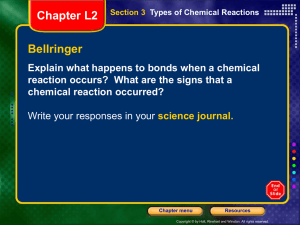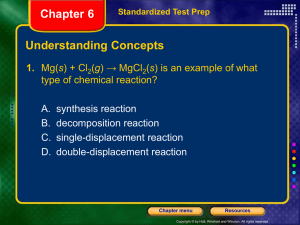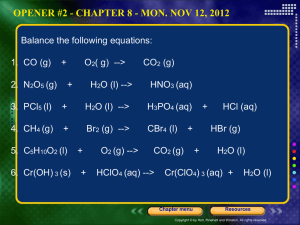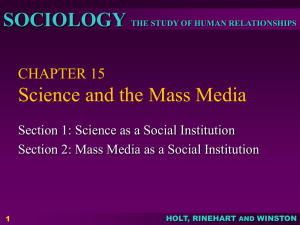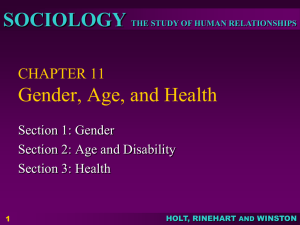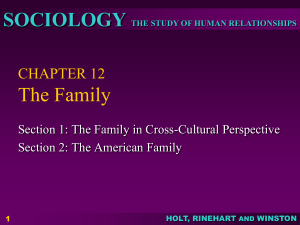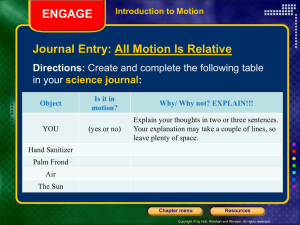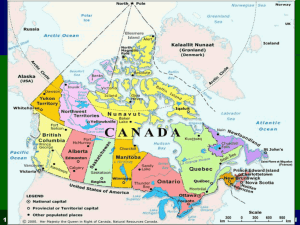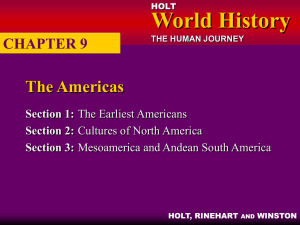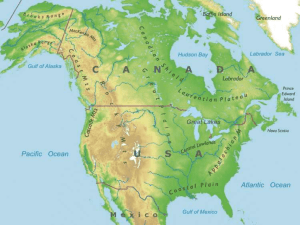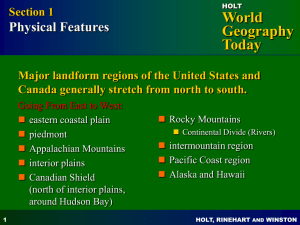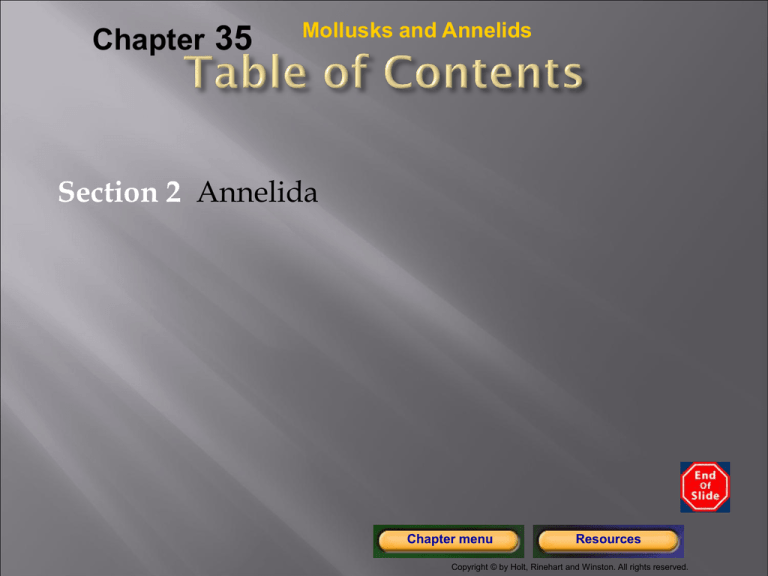
Chapter 35
Mollusks and Annelids
Section 2 Annelida
Chapter menu
Resources
Copyright © by Holt, Rinehart and Winston. All rights reserved.
Chapter 35
Section 2 Annelida
Identify the structures that provide the basis
for dividing annelids into three classes.
List the advantages of body segmentation.
Describe the structural adaptations of
earthworms.
Compare the three classes of annelids.
Chapter menu
Resources
Copyright © by Holt, Rinehart and Winston. All rights reserved.
Chapter 35
Section 2 Annelida
The phylum Annelida is made up of bilaterally symmetrical,
segmented worms.
This phylum includes common earthworms, feather-duster
worms, and bloodsucking leeches.
They are called annelids, which means “little rings” and refers to
the many body segments.
Annelids have a true coelom that is divided into separate
compartments by partitions.
Most annelids have external bristles called ___________ (singular,
seta), and some have fleshy protrusions called ______________
(singular, parapodium).
Chapter menu
Resources
Copyright © by Holt, Rinehart and Winston. All rights reserved.
Chapter 35
Section 2 Annelida
Annelids of the class ________________ generally live in the soil or
in fresh water and have no parapodia.
Oligochaeta means “few bristles”; these annelids have a few setae
on each segment.
The most familiar member is the ______________________.
Structure and Movement
An earthworm’s body has over 100 nearly-identical segments.
Circular and longitudinal muscles line the interior body wall.
Locomotion is made possible by segmentation.
Chapter menu
Resources
Copyright © by Holt, Rinehart and Winston. All rights reserved.
Chapter 35
Section 2 Annelida
Feeding and Digestion
Earthworms ingest soil as they burrow through it.
Soil is moved through these structures:
___________
____________
______________
__________
___________
___________
includes the ______________
__________
Earthworms play an important role in the condition of soil.
Chapter menu
Resources
Copyright © by Holt, Rinehart and Winston. All rights reserved.
Chapter 35
Section 2 Annelida
Circulation
Contractions of the ____________________and the dorsal blood
vessel force blood through the closed circulatory system.
Respiration and Excretion
Oxygen and carbon dioxide diffuse through the skin, which
contains many small blood vessels and must be kept moist.
Cellular wastes and excess water are excreted through
_______________.
Neural Control
The nervous system of an earthworm consists of a chain of
ganglia connected by a ventral nerve cord.
Sensory structures are found in all segments but are concentrated
at the anterior end.
Chapter menu
Resources
Copyright © by Holt, Rinehart and Winston. All rights reserved.
Chapter 35
Section 2 Annelida
Reproduction
Earthworms are ____________________, but an individual
worm cannot fertilize its own eggs.
During mating, earthworms press their ventral surfaces
together.
They are held together by their setae and by a film of mucus
secreted by each worm’s _______________.
The sperm from each worm move through the mucus to the
seminal receptacle of the other.
The clitellum secretes a tube of mucus and __________.
Fertilization occurs inside the tube, which forms a protective
case for the young worms.
Chapter menu
Resources
Copyright © by Holt, Rinehart and Winston. All rights reserved.
Chapter 35
Section 2 Annelida
Most annelids are members of the class Polychaeta, which means
“many bristles.”
Polychaetes differ from other annelids in that they have antennae
and specialized mouthparts.
They are the only annelids that have a trochophore stage.
Hirudinea is the smallest class of annelids, consisting of about 500
species of ______________.
Leeches have no setae or parapodia.
Many leeches are carnivores but some are parasites that suck
blood from other animals.
Chapter menu
Resources
Copyright © by Holt, Rinehart and Winston. All rights reserved.
Chapter 35
Section 2 Annelida
Chapter menu
Resources
Copyright © by Holt, Rinehart and Winston. All rights reserved.
Chapter 35
Standardized Test Prep
1. Why do terrestrial snails and slugs need an
environment with a high moisture content?
A. to avoid drying out
B. to see and hear better
C. to swim more efficiently
D. to avoid being eaten by birds
Chapter menu
Resources
Copyright © by Holt, Rinehart and Winston. All rights reserved.
Chapter 35
Standardized Test Prep
1. Why do terrestrial snails and slugs need an
environment with a high moisture content?
A. to avoid drying out
B. to see and hear better
C. to swim more efficiently
D. to avoid being eaten by birds
Chapter menu
Resources
Copyright © by Holt, Rinehart and Winston. All rights reserved.
Chapter 35
Standardized Test Prep
2. Which of the following are the only mollusks
with a closed circulatory system?
F. snails
G. bivalves
H. gastropods
J. cephalopods
Chapter menu
Resources
Copyright © by Holt, Rinehart and Winston. All rights reserved.
Chapter 35
Standardized Test Prep
2. Which of the following are the only mollusks
with a closed circulatory system?
F. snails
G. bivalves
H. gastropods
J. cephalopods
Chapter menu
Resources
Copyright © by Holt, Rinehart and Winston. All rights reserved.
Chapter 35
Standardized Test Prep
3. Annelids are divided into three classes based
partly on the number of which of the
following?
A. setae
B. segments
C. nephridia
D. aortic arches
Chapter menu
Resources
Copyright © by Holt, Rinehart and Winston. All rights reserved.
Chapter 35
Standardized Test Prep
3. Annelids are divided into three classes based
partly on the number of which of the
following?
A. setae
B. segments
C. nephridia
D. aortic arches
Chapter menu
Resources
Copyright © by Holt, Rinehart and Winston. All rights reserved.
Chapter 35
Standardized Test Prep
4. Parapodia are distinguishing characteristics of
which class of annelids?
F. Bivalvia
G. Hirudinea
H. Polychaeta
J. Oligochaeta
Chapter menu
Resources
Copyright © by Holt, Rinehart and Winston. All rights reserved.
Chapter 35
Standardized Test Prep
4. Parapodia are distinguishing characteristics of
which class of annelids?
F. Bivalvia
G. Hirudinea
H. Polychaeta
J. Oligochaeta
Chapter menu
Resources
Copyright © by Holt, Rinehart and Winston. All rights reserved.
Chapter 35
Standardized Test Prep
The diagram below shows the internal structure
of a bivalve. Use the diagram to answer the
questions that follow.
Chapter menu
Resources
Copyright © by Holt, Rinehart and Winston. All rights reserved.
Chapter 35
Standardized Test Prep
5. Which of the structures is involved in
respiration and feeding?
A. A
B. B
C. C
D. D
Chapter menu
Resources
Copyright © by Holt, Rinehart and Winston. All rights reserved.
Chapter 35
Standardized Test Prep
5. Which of the structures is involved in
respiration and feeding?
A. A
B. B
C. C
D. D
Chapter menu
Resources
Copyright © by Holt, Rinehart and Winston. All rights reserved.
Chapter 35
Standardized Test Prep
6. What is structure B?
F. a gill
G. a siphon
H. the mantle
J. an adductor muscle
Chapter menu
Resources
Copyright © by Holt, Rinehart and Winston. All rights reserved.
Chapter 35
Standardized Test Prep
6. What is structure B?
F. a gill
G. a siphon
H. the mantle
J. an adductor muscle
Chapter menu
Resources
Copyright © by Holt, Rinehart and Winston. All rights reserved.
Chapter 35
Standardized Test Prep
7. Nephridium : excretion :: clitellum :
A. digestion
B. circulation
C. respiration
D. reproduction
Chapter menu
Resources
Copyright © by Holt, Rinehart and Winston. All rights reserved.
Chapter 35
Standardized Test Prep
7. Nephridium : excretion :: clitellum :
A. digestion
B. circulation
C. respiration
D. reproduction
Chapter menu
Resources
Copyright © by Holt, Rinehart and Winston. All rights reserved.
Chapter 35
Standardized Test Prep
The diagram below shows the mouth structure of
a class of organisms. Use the diagram to
answer the question that follows.
Chapter menu
Resources
Copyright © by Holt, Rinehart and Winston. All rights reserved.
Chapter 35
Standardized Test Prep
8. In which class of organisms is the mouth
structure shown above most likely to be found?
F. bivalves
G. hirudines
H. gastropods
J. polychaetes
Chapter menu
Resources
Copyright © by Holt, Rinehart and Winston. All rights reserved.
Chapter 35
Standardized Test Prep
8. In which class of organisms is the mouth
structure shown above most likely to be found?
F. bivalves
G. hirudines
H. gastropods
J. polychaetes
Chapter menu
Resources
Copyright © by Holt, Rinehart and Winston. All rights reserved.
Chapter 35
Standardized Test Prep
During larval development, gastropods
undergo a process called torsion.
Describe the outcome of torsion.
Chapter menu
Resources
Copyright © by Holt, Rinehart and Winston. All rights reserved.
Chapter 35
Standardized Test Prep
During larval development, gastropods
undergo a process called torsion.
Describe the outcome of torsion.
Answer: Torsion is a developmental process
in which the visceral mass twists around
180 degrees in relation to the head, bringing
the mantle cavity to the anterior end of the
snail.
Chapter menu
Resources
Copyright © by Holt, Rinehart and Winston. All rights reserved.
Chapter 35
Standardized Test Prep
Base your answers to parts A & B on the
information below.
Earthworms have three main structural
features that enable movement.
Part A Describe these features.
Part B Explain how they work together to
Chapter menu
Resources
enable movement.
Copyright © by Holt, Rinehart and Winston. All rights reserved.
Chapter 35
Standardized Test Prep
Answer:
Part A Circular muscles and longitudinal muscles line the
interior body wall of an earthworm. Setae, or external
bristles, line the ventral surface of the earthworm.
Coelomic fluid is found in individual segments.
Part B: Contractions of the circular muscles increase the
pressure of the coelomic fluid. This increased pressure
causes the animal to elongate and pushes the anterior end
forward. The animal then uses its setae to grip the ground
as the longitudinal muscle contracts, pulling the posterior
end forward.
Chapter menu
Resources
Copyright © by Holt, Rinehart and Winston. All rights reserved.

